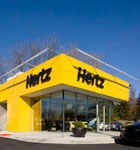The impetus for change is preceded by the realization that change is necessary. The Hertz Corporation, the international vehicle- and equipment-renting organization, made such a determination at the beginning of 2011. Environmental responsibility has been one of Hertz’s core values for years, but early last year, the need for a more centralized and comprehensive plan was realized.
“We made the commitment a year ago to take our initiatives to the next level—expand upon what we were doing and formulate a sustainability plan that can be endorsed by the CEO and senior management—and we have done just that,” says Sue Pinera, the director of environmental programs at Hertz.

The Hertz Rent-a-Car facility at Hartsfield-Jackson Atlanta International Airport is LEED certified as part of the consolidated rental facility, a green trend that’s sweeping the country.
One of the central issues that needed attention and examination was wide-scale energy management across Hertz’s nationwide portfolio. But the requisite first step was data collection. “In order to be successful here, the baseline data has to be measured so we can understand our success factor,” says Todd Poste, Hertz’s vice president of procurement. The initial assessment of more than 30 locations included an examination of all quantitative energy use. Benchmarking and comparative analysis were necessary due to the different classes of Hertz facilities. “What the analysis allows us to do is prioritize where the opportunities are on a very macro level,” Poste says.
Once the priorities were set, Hertz was able to drill down into the operations of each property and approach energy management much more strategically. The company looked at lighting, HVAC systems, and behavioral measures. It also will be adding photovoltaic solar panels to 15 locations this year thanks to a partnership with Martifer Solar, whose 2.48-megawatt arrays generate enough electricity to power 300 homes in a year. Aiding in the implementation of green policies is CBRE, Hertz’s outsourced provider of facilities management and also the company’s project management team.
Another important partner has been the USGBC, specifically the New Jersey and Washington, DC, chapters, which have helped Hertz navigate the potential opportunities within the LEED Volume Program. In preparation for submitting a prototype location, Hertz is going through the LEED process with its new service center in Albany, New York, a facility used for cleaning and maintenance. The goal is LEED Silver, and going through the initial checklist, Hertz has identified 52 possible points for things like alternative transportation options for employees, storm-water management, reduced heat island effect, optimal energy performance, reduced water use, waste management, regional materials, and indoor air quality.
If 2011 was about analysis and preparation, 2012 will be all about implementation. “[This year] is going to be really exciting for us on the sustainability side,” Pinera says. “[Last year] was focused on getting the framework … and people in place, and now we can implement our programs.” Further evidence of the new commitment can be seen at Hertz’s new sustainability website, hertzlivingjourney.com, introduced in January.

